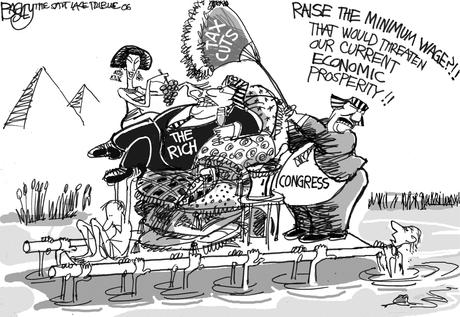Every once in a while a news headline on Yahoo’s home page catches my eye, mostly because it seems completely ridiculous. Yesterday was no exception when I saw the ominous headline “Restaurants in Seattle Going Dark as $15 an Hour Minimum Wage Looms“. A scary headline for an article with content that shouldn’t scare anyone that made it past kindergarten.
When it comes to right-wing scare tactics on minimum wage increases in general, one is forced to accept a fallacy that would crush their argument if they ever had to address it. The fallacy is this: people making minimum wage would not spend the extra money they would make from a wage increase. In other words, the money would simply be paid to them and then find its way into a black hole, never to be heard from again. There would be no increase in consumer spending on basic products or other goods and services and no increase in the sales and production of residual businesses not paying their workers minimum wage. The article linked is no exception as it feeds the reader the fallacy and makes no mention of the reality of minimum wage increases. 
Another right-wing tactic is to always focus on restaurants and how they will fail if the minimum wage is ever increased. This is nothing more than using a convenient target to try to sway the uninformed. Depending on what statistics you use, the failure rate of restaurants in the first three years is generally accepted at roughly 60%. In other words, most restaurants will fail regardless of the minimum wage so its an easy but deceiving target for the right to use when arguing their absurd points.
While this is no surprise, there is another snippet of info given in the piece that deserves further analysis. The article gives us some numbers that seem scary on the surface when read:
Washington Restaurant Association’s Anthony Anton puts it this way: “It’s not a political problem; it’s a math problem.”
“He estimates that a common budget breakdown among sustaining Seattle restaurants so far has been the following: 36 percent of funds are devoted to labor, 30 percent to food costs and 30 percent go to everything else (all other operational costs). The remaining 4 percent has been the profit margin, and as a result, in a $700,000 restaurant, he estimates that the average restauranteur in Seattle has been making $28,000 a year.
Gasp! The owner only making $28k a year on a $700k a year restaurant? Sounds horrific…unless we choose to do some math. Let’s play this game.
$700k divided by 365 days gives us an average daily revenue of $1918. Let’s assume the restaurant is open on average 12 hours a day (10 am-10 pm, for example, lunch and dinner). $1918 divided by 12 gives us roughly $160 per hour. Assuming the average customer spends $10 per meal and drink, we get 16 customers per hour. If a restaurant in a major city like Seattle is only getting that many customers per hour, they are clearly on their way to closing their doors anyway. But wait, there’s more.
As is noted, 36% of funds are devoted to labor. 36% of $700k is 252000. A 36-hour per week worker (6 days, 6 hours per in this scenario) making Washington’s minimum wage ($9.47) makes $17,725 a year. $252k divided by $17,725 gives us roughly 14 workers. With a 12 hour day, you would need a minimum of two workers per position. That gives us 2 hosts/hostesses (assuming you need it), 2 cooks, 2 kitchen preps, 2 dishwashers, 1 additional manager, and 5 servers (who apparently make the state minimum wage in Washington). Here’s where an important reality comes to light in their numbers given.
With 5 servers, you would have 3 working half of the time to split the previously derived 16 customers per hour, which is completely ridiculous in terms of being grossly overstaffed. Assuming the 16 customers are 8 couples dining together, this means a little less than 3 tables per hour per server. As someone who was once an atrocious excuse for a server in my earlier working days and can speak from experience, a server can easily handle 6-7 tables per hour without breaking much of a sweat. And that’s if you’re terrible at your job, like I was.
In other words, the restaurant in the example given is clearly overstaffed and badly run on top of not getting enough foot traffic in the first place. If we were to bring the server situation down to a more appropriate level, what happens with the owner’s $28k a year takeaway on a $700k restaurant? What if you take away 1 or both hosts/hostesses because they aren’t needed due to the light customer traffic? If we take out 4 workers, we suddenly get an additional $70k. Obviously, some of this would go to the additional manager and (hopefully) some raises, but the owner is likely taking a good chunk of this home. What happens to that $28k per year? Exactly.
If the right wants to scare the country into believing the minimum wage should not be increased or should go away entirely, they should probably use a better hypothetical example than a badly run, overstaffed restaurant with too little of a customer base to survive in such a big city.

